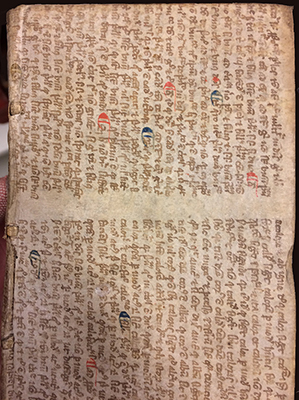During a recent shift of rare books in Lauinger Library, I came upon a treasure trove of waste. Not quite what you might imagine when you hear the word “waste,” but more along the lines of an unexpected surprise to the literary imagination.
A few days later a set of questions was posted to a listserv that I follow:
What if you had a book, or set of books, of minor importance but discovered that the lining consisted of at least a portion of a highly important and rare text? Or some manuscript not previously known but of great importance? Or that the series of books each contained some portion of this manuscript? Would it then be prudent to remove the more “valuable” (in historical terms at least) material, even if you had to rebind the original volume(s) in more recent materials? Has this been known to happen?
In John Carter’s ABC for Book Collectors, waste is defined:
Spoiled or surplus printed sheets are called waste. Binders have often used these in the back of a volume, for making up boards, or in earlier days for endpapers. Such waste might derive either from a printing house (proofs, trial sheets, over-running the desired quantity) or from a bookseller (surplus quires or spoiled copies of recent books, discarded fragments of old ones). Bookseller’s waste might have come from anywhere, and few conclusions can be automatically drawn from the presence of an identified piece of it found in a binding. But printer’s waste was normally disposed of nearby and can often be helpful evidence for localising the binding in which it was used.
What does one do with these hybrid creatures? Bookbinders often used “waste” material from broken books or discarded sheets to help make new ones. When manuscripts were replaced with printed copies (gasp!) the discarded manuscript was recycled to become new material for bindings. Today, this is regarded as an invaluable part of a book. Yet it raises questions: Where did the manuscript come from? Who owned it? When was the manuscript created? How do you catalog this waste that binds the text inside? It’s all a mystery until you start looking with a sharp eye.
Georgetown has a large number of books that are bound with this recycled material, just awaiting your investigative curiosity. Who knows what hidden treasures you might find?
Ethan Henderson, Rare Books Curator
October 26, 2016

